Navigation
Conservation of Butterflies in Assam, India: Setting example for worldwide efforts.
The state of Assam in northeastern India, harboring some of the world’s riches biodiversity, is home to more than 500 species of butterflies. Large-scale habitat deforestation and fragmentation has led to the decline of several butterfly populations in the state, and many species believed to be common during the early part of the 20th Century have now declined rapidly through much of their range.
Problem Overview:
The state of Assam in northeastern India, harboring some of the world’s riches biodiversity, is home to more than 500 species of butterflies. Large-scale habitat deforestation and fragmentation has led to the decline of several butterfly populations in the state, and many species believed to be common during the early part of the 20th Century have now declined rapidly through much of their range. This decline in species, so typical of the third-world today, is an indication of the ongoing global environmental crisis, and if not checked will perhaps reach a point where downward trends can no longer be reversed.
In the state of Assam, as over much of the Indian sub-continent, there is very little conservation activity directed towards butterflies.
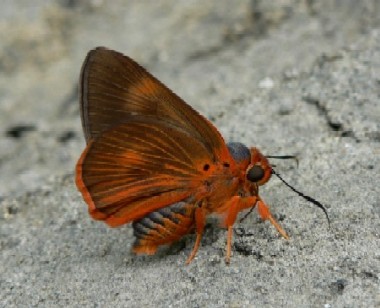 |
| Orange Awlet an uncommon butterfly found in the forests of Assam Photo by MV Nair |
Over much of India, butterflies are treated as non-target species in the conservation and management of wildlife. The current “Protected Area Network” of the country set up by the Government, is directed towards the conservation of ‘flagship species’ such as the Tiger and Indian Rhino. The important inter-specific relationships and landscape-level ecological processes taking place through smaller life-forms are largely ignored.
Butterflies serve as important plant pollinators in the local environment, and help pollinate more than 50 economically important plant crops. The thousand-year old silk industry of the state is also dependent on Lepidoptera, but increased pesticide use in the region has caused population declines of silk moths. Butterflies act as important indicators of environmental health and the ‘ecosystem services’ provided by Lepidoptera is immense. However a contemporary discourse regarding butterfly conservation and its importance is lacking amongst the public.
As there are no names for butterflies in regional languages, let alone access to detailed information, people’s awareness regarding butterflies and their conservation is almost next to nothing. It is for this reason butterflies have failed to be a part of the environmental debate in the region.
Academic research on butterflies is also lacking and there is no readily available published information or baseline data on butterflies of the region. Although
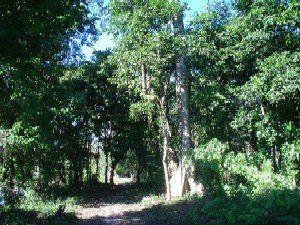 |
| Forests such as Nameri National Park are extremely rich in butterfly diversity but lack information on butterflies. |
inventories exist for several other biological groups, the parks and sanctuaries of the state do not even have butterfly lists. Moreover, very few serious ecological studies on the Lepidoptera of the region have been undertaken and thus very little technical information is available for managers and policy makers to take steps for effective butterfly conservation.
Objectives
Keeping this in mind, the main regions of work were identified. This primarily includes fieldwork in Assam in order to gather baseline data on butterflies and to identify threats that butterflies face. Research and documentation of butterfly species, their taxonomy and habitat are some of the first steps that are being initiated in order to get an overview of the current status of butterflies in the region.
Effective conservation of butterflies though must be achieved through awareness and participation of people, because biological resources need protection against inappropriate uses and overexploitation.
Thus, there is a need for awareness regarding problems facing butterfly conservation amongst the public. There is also a need for capacity building at grassroots level in order to form a conservation working group and a network to study butterflies. Consequently, suitable target groups have been identified and these include (a) individuals from semi-urban and rural areas who are greater stakeholders in conservation, (b) youth, (c) Forest (Rangers) Guards and other managers of wildlife reserves.
Current Activities
The main activities the project is currently involved in include:
Research and Documentation of Butterflies
Field work has been initiated to look at butterfly diversity in the region. Surveys of four major protected areas have been undertaken, and to date over 200 species of butterflies have been identified. A comprehensive survey of butterflies of Kaziranga National Park, a UNESCO world heritage site has been conducted, and baseline data for Orang and Nameri National Park and Gibbon Wildlife Sanctuary is being developed.
Impact of Tea Estates on Butterfly Populations:
A major study of the impact of tea estates on butterfly populations has been carried out by Maan Barua.
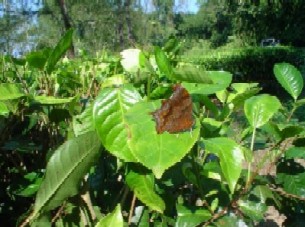 |
| Tea estates have fragmented the habitat of several butterflies, notably of forest dwelling species. |
Tea estates replace indigenous vegetation with monoculture plantations. It has been found that butterfly species diversity and density is considerably lower in tea estates than in semi-evergreen forest. This is due to both destruction of habitat and extensive use of pesticides in tea estates.
Once complete, results of this study will be published in journals and recommendations and suggestions for improving the tea estate habitat will be discussed with stalwarts of the tea industry.
Butterfly-Plant Interactions: Besides this, studies of butterfly-plant interactions have also been carried out, notably on that of the impact of weeds on butterfly distribution.
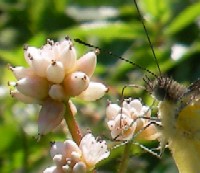 |
| The study of Butterfly-Plant interactions is of great importance for conservation |
People’s Knowledge of Butterfly Natural History and Conservation: Part of the programme is also to undertake attitude surveys in order to gain knowledge regarding people’s awareness of butterfly conservation. A survey of people’s attitudes and understanding of butterfly life-history, ecology and conservation was undertaken. It was found that knowledge is extremely limited and that there is need for broad-scale awareness in order to facilitate butterfly conservation in the state. A survey of people’s attitudes towards pesticide use is being initiated.
A photo database of the butterflies of the region is being developed in order to help people with butterfly identification. This will later be collated into an accessible Website for interested people.
Project on the Nomenclature of Butterflies
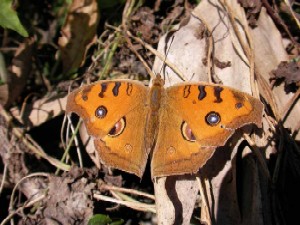 |
| Local names are not available for even the more common and conspicuous species such as Peacock Pansy. |
One of the startling results of the attitude survey has been the complete absence of names of specific butterflies in the Assamese language. The lack of understanding of butterfly natural history and conservation stems from this void. Thus a team has started work on translating Latin names of butterflies (by Ellin Beltz, USA) in order to assist the creation of Assamese names. A team comprising of a litterateur, Latin scholar and biologist has been formed in order to initiate the naming process. The primary aim of this activity is to make accessible the entire world of butterflies to local communities and to disseminate information on butterflies amongst the public.
To supplement this, a butterfly identification key is being prepared. 80 common and important butterflies of the region will be depicted, showing butterflies photographed in the field. This will help all beginners and amateurs with an interest in butterflies, as well as those to be engaged in further fieldwork on butterflies in the region.
Dissemination of Information on Butterflies
In order to create awareness amongst the public at large, a poster on butterflies is being printed.
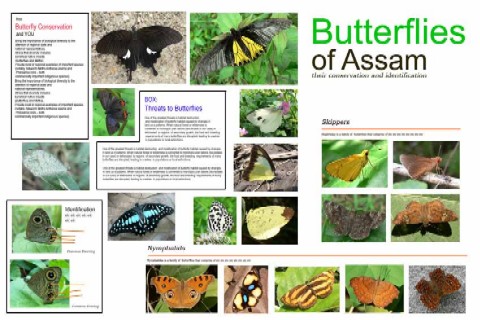 |
| Creation of a poster on butterflies will help disseminate information and further enhance butterfly study in the region. |
The main thrust of this poster is to portray butterfly diversity, threats to butterflies resulting from habitat destruction, pesticide use, as well as the importance of butterflies to man and their role in providing ecosystem-services. This will be done in simple, jargon-free language in order to reach out to a wider public.
There is also a need to popularize the study of butterflies in the region. Thus existing publications such as newspapers and popular science magazines are being approached in order to carry a column or articles on butterflies in regional languages. A radio interview regarding conservation was recently aired in the All-India Radio, reaching an audience over a million people.
Identify Target Groups and Training Individuals
Interested individuals and organizations have been contacted, and a process to form a Butterfly Conservation Working Group has started. This includes liaison with existing nature networks and organizations that are interested in working on butterflies and to hold training camps on butterfly identification and conservation in various parts of the state.
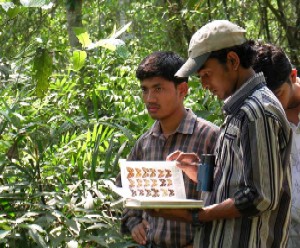 |
| Participation of rural youth in butterfly fieldwork. |
Efforts have been made at training interested individuals to understand butterfly conservation and take up studies on butterflies. A few individuals have been trained to identify butterflies and to participate in butterfly monitoring schemes. This is the first of its kind in the state. Active work with rural youth, greater stakeholders in conservation, has begun, and a schedule for holding short training camps in various parts of the state is being chalked out.
An effort is being made to hold a meeting of Butterfly-India, the country’s only butterfly network, in the region so that interested youth and other individuals can meet butterfly enthusiasts and Lepidopertologists from various parts of the country.
Desired Objectives and Results
The final outcomes of this effort will essentially be to suggest potential solutions for current butterfly declines incorporating both Forest Department and people’s participation. Based on the process and outcomes the replicability of the initiatives may be assessed and conducted in different parts of the world. Some of the goals, both immediate and long-term would be:
- To create a group that conducts research, field studies and monitors butterfly populations in the region;
- To suggest potential solutions for current butterfly declines and draw in various agencies and the public into a debate for conserving butterflies;
- To publish a newsletter on butterflies and start a website on butterflies of the region; and,
- To build a network that furthers long-term butterfly conservation at regional and international levels.
Box 1: Horizon International and Butterfly Conservation in Assam
This project is being accomplished with the partnership of Horizon International, a non-profit organization working with people involved in various fields of the environment and health to advance solutions. Horizon helps young people working in the field of conservation to realize their potential and to network and share solutions to conserve the rich natural heritage of their environment. Hence, the involvement aims at fostering butterfly conservation in the region and seeking solutions that aim at doing so.
Horizon will help launch this effort onto an international platform and explore the scope of replicating similar processes in other parts of the world, notably in developing countries where butterflies face severe threats and where there is paucity of information on butterflies.
Maan Barua, the leader of the project, is currently doing an internship with Horizon International. Horizon is working on liaisons with Lepidopterologists so that desirable input can be given to the project.
Contact author:
Maan Barua
Wild Grass
Kaziranga, Assam 785109,
India
Maan Barua is also the photographer of all of the photographs except as otherwise indicated.
About the author:
Bittu Sahgal,Editor, Sanctuary Magazine, wrote:
He is one of India's most promising ornithologists and is currently doing extensive work fieldwork on the birds of Assam. His on-going field studies include impact of habitat change on butterfly populations and such works deal with the issue of loss of biodiversity as a result of large-scale habitat change.
He has worked extensively with village youth at grass-roots level in Assam, eastern India and this work is primarily aimed at building a social base for conservation oriented work. Working with indigenous cultures and ecological issues has resulted in the region's first works looking at the effect of environment and cultural change.
Maan has over 20 publications in journals both in India and abroad, and is currently working on a book on the common birds of Assam. He was also awarded the Carl Zeiss Role of Honour 2005 for excellence and commitment to wilderness areas.
Search
Latest articles
Agriculture
- World Water Week: Healthy ecosystems essential to human health: from coronavirus to malnutrition Online session Wednesday 24 August 17:00-18:20
- World Water Week: Healthy ecosystems essential to human health: from coronavirus to malnutrition Online session Wednesday 24 August 17:00-18:20
Air Pollution
- "Water and Sanitation-Related Diseases and the Changing Environment: Challenges, Interventions, and Preventive Measures" Volume 2 Is Now Available
- Global Innovation Exchange Co-Created by Horizon International, USAID, Bill and Melinda Gates Foundation and Others
Biodiversity
- World Water Week: Healthy ecosystems essential to human health: from coronavirus to malnutrition Online session Wednesday 24 August 17:00-18:20
- Mangrove Action Project Collaborates to Restore and Preserve Mangrove Ecosystems
Desertification
- World Water Week: Healthy ecosystems essential to human health: from coronavirus to malnutrition Online session Wednesday 24 August 17:00-18:20
- UN Food Systems Summit Receives Over 1,200 Ideas to Help Meet Sustainable Development Goals
Endangered Species
- Mangrove Action Project Collaborates to Restore and Preserve Mangrove Ecosystems
- Coral Research in Palau offers a “Glimmer of Hope”
Energy
- Global Innovation Exchange Co-Created by Horizon International, USAID, Bill and Melinda Gates Foundation and Others
- Wildlife Preservation in Southeast Nova Scotia
Exhibits
- Global Innovation Exchange Co-Created by Horizon International, USAID, Bill and Melinda Gates Foundation and Others
- Coral Reefs
Forests
- NASA Satellites Reveal Major Shifts in Global Freshwater Updated June 2020
- Global Innovation Exchange Co-Created by Horizon International, USAID, Bill and Melinda Gates Foundation and Others
Global Climate Change
- World Water Week: Healthy ecosystems essential to human health: from coronavirus to malnutrition Online session Wednesday 24 August 17:00-18:20
- Mangrove Action Project Collaborates to Restore and Preserve Mangrove Ecosystems
Global Health
- World Water Week: Healthy ecosystems essential to human health: from coronavirus to malnutrition Online session Wednesday 24 August 17:00-18:20
- More than 400 schoolgirls, family and teachers rescued from Afghanistan by small coalition
Industry
- "Water and Sanitation-Related Diseases and the Changing Environment: Challenges, Interventions, and Preventive Measures" Volume 2 Is Now Available
- Global Innovation Exchange Co-Created by Horizon International, USAID, Bill and Melinda Gates Foundation and Others
Natural Disaster Relief
- STOP ATTACKS ON HEALTH CARE IN UKRAINE
- Global Innovation Exchange Co-Created by Horizon International, USAID, Bill and Melinda Gates Foundation and Others
News and Special Reports
- World Water Week: Healthy ecosystems essential to human health: from coronavirus to malnutrition Online session Wednesday 24 August 17:00-18:20
- STOP ATTACKS ON HEALTH CARE IN UKRAINE
Oceans, Coral Reefs
- World Water Week: Healthy ecosystems essential to human health: from coronavirus to malnutrition Online session Wednesday 24 August 17:00-18:20
- Mangrove Action Project Collaborates to Restore and Preserve Mangrove Ecosystems
Pollution
- Zakaria Ouedraogo of Burkina Faso Produces Film “Nzoue Fiyen: Water Not Drinkable”
- "Water and Sanitation-Related Diseases and the Changing Environment: Challenges, Interventions, and Preventive Measures" Volume 2 Is Now Available
Population
- "Water and Sanitation-Related Diseases and the Changing Environment: Challenges, Interventions, and Preventive Measures" Volume 2 Is Now Available
- "Water and Sanitation-Related Diseases and the Changing Environment: Challenges, Interventions, and Preventive Measures" Volume 2 Is Now Available
Public Health
- Honouring the visionary behind India’s sanitation revolution
- Honouring the visionary behind India’s sanitation revolution
Rivers
- World Water Week: Healthy ecosystems essential to human health: from coronavirus to malnutrition Online session Wednesday 24 August 17:00-18:20
- Mangrove Action Project Collaborates to Restore and Preserve Mangrove Ecosystems
Sanitation
- Honouring the visionary behind India’s sanitation revolution
- Honouring the visionary behind India’s sanitation revolution
Toxic Chemicals
- "Water and Sanitation-Related Diseases and the Changing Environment: Challenges, Interventions, and Preventive Measures" Volume 2 Is Now Available
- Actions to Prevent Polluted Drinking Water in the United States
Transportation
- "Water and Sanitation-Related Diseases and the Changing Environment: Challenges, Interventions, and Preventive Measures" Volume 2 Is Now Available
- Urbanization Provides Opportunities for Transition to a Green Economy, Says New Report
Waste Management
- Honouring the visionary behind India’s sanitation revolution
- Honouring the visionary behind India’s sanitation revolution
Water
- Honouring the visionary behind India’s sanitation revolution
- Honouring the visionary behind India’s sanitation revolution
Water and Sanitation
- Honouring the visionary behind India’s sanitation revolution
- Honouring the visionary behind India’s sanitation revolution

